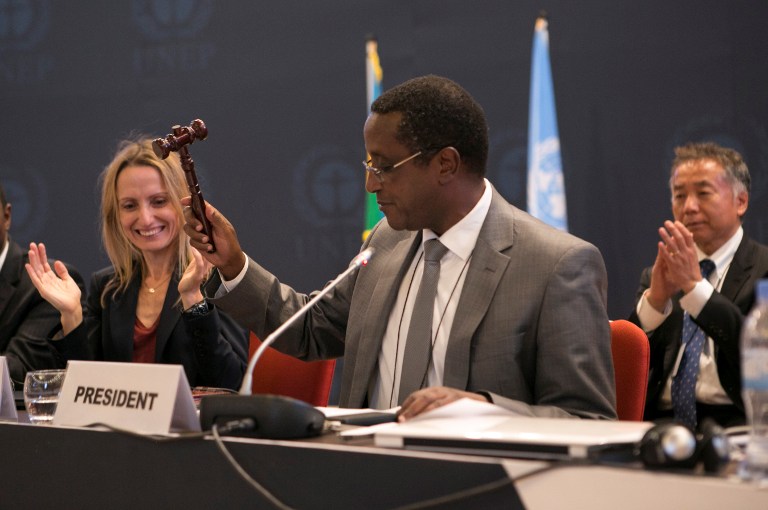
The world community agreed Saturday (October 15, 2016) to phase out a category of dangerous greenhouse gases widely used in refrigerators and air conditioners.
Nearly 200 countries agreed to end production and consumption of so-called hydrofluorocarbons (HFCs) under an amendment to the 1987 Montreal Protocol on protecting the ozone layer.
/ AFP PHOTO / Cyril NDEGEYA
by Dave Clark and Stephanie Aglietti
KIGALI, Rwanda | AFP | — In a major step toward curbing global warming, the world community agreed on Saturday to phase out a category of dangerous greenhouse gases widely used in refrigerators and air conditioners.
Nearly 200 countries agreed to end production and consumption of so-called hydrofluorocarbons (HFCs) under an amendment to the 1987 Montreal Protocol on protecting the ozone layer.
HFCs stoke climate change because they are super-efficient at trapping heat in Earth’s atmosphere.
By scrapping these substances, say experts, a massive step could be made towards achieving the UN’s goal to roll back global warming.
The agreement was greeted by applause from exhausted envoys who worked through the night in Rwanda’s capital Kigali to put the finishing touches on the deal.
“Last year in Paris, we promised to keep the world safe from the worst effects of climate change. Today, we are following through on that promise,” UN Environment Programme chief Erik Solheim declared.
– Deal hailed –
US President Barack Obama said in a White House statement that the agreement was “an ambitious and far-reaching solution to (the) looming crisis” of climate change.
It adds powerfully to the 2015 Paris Agreement, due to take effect next month after crossing the threshold for ratification by signatory countries, Obama said.
“Together, these steps show that, while diplomacy is never easy, we can work together to leave our children a planet that is safer, more prosperous, more secure, and more free than the one that was left for us.”
Among green groups, WWF said the deal was “great news for the climate”.
“It sends a powerful signal that our governments are serious about tackling climate change,” its climate spokeswoman Regine Guenther said.
Under the agreement, rich countries will move faster than developing giants to scrapping HFCs — a concession that was a source of regret for some.
“It may not be entirely what the islands wanted, but it is a good agreement,” said a representative of the tiny Pacific nation of the Marshall Islands, Mattlan Zackhras, whose country is badly exposed to sea-level rise.
“We all know we must go further, and we will go further.”
Christian Aid’s senior policy advisor, Benson Ireri, added: “It was a shame that India and a handful of other countries chose a slower timeframe for phasing down HFCs.”
But he said the international community had passed its “first real test” since the historic Paris climate deal.
– Climate boost –
The Paris Agreement aims to keep global warming below two degrees Celsius (3.6 Fahrenheit), compared with pre-industrial levels.
Its principal target is carbon dioxide (CO2), emitted especially by coal, oil and gas.
As these sources are the mainstays of the world’s energy supply, reducing carbon pollution has been a painfully slow and rancorous affair, marked by bickering over who should shoulder the burden for energy efficiency and the switch to cleaner sources.
Right now, Earth is on track for several degrees of warming by century’s end — a scenario that climatologists fear will doom the planet to worse droughts, floods, storms and rising seas.
Eliminating HFCs — which are dealt with under the Montreal Protocol, not the Paris Agreement — could be a relatively swift and easy way to ease the warming and buy time, say specialists.
It could reduce global warming by 0.5 C by 2100, according to a 2015 study by the Institute for Governance and Sustainable Development.
HFCs were introduced in the 1990s to replace chlorofluorocarbons (CFCs) that had been found to erode the ozone layer, the stratospheric shield which protects life on Earth from damaging solar radiation.
But it emerged that HFCs, while safer for the now-healing ozone layer, are potentially thousands of times worse for trapping heat than CO2.
– Cost wrangle –
Swapping HFCs for alternatives such as ammonia, water or gases called hydrofluoroolefins could prove expensive for hot developing countries, where air-conditioner use is soaring.
For India, this was one of the sticking points.
“There are issues of cost, there are issues of technology,” said Ajay Narayan Jha of India’s environment and climate change ministry before the deal was announced.
“We would like to emphasise that any agreement will have to be flexible from all sides concerned. It can’t be flexible from one side and not from the other.”
Under the legally binding deal, developed countries must slash their use of HFCs by 10 percent by 2019 from 2011-2013 levels, and then by 85 percent by 2036.
A second group of developing countries, including China and African nations, are committed to launching the transition in 2024.
A reduction of 10 percent compared with 2020-2022 levels should be achieved by 2029, to be extended to 80 percent by 2045.
A third group of developing countries, including India, Pakistan, Iran, Iraq and Gulf nations, must begin the process in 2028 and reduce emissions by 10 percent by 2032 from 2024-2026 levels, and then by 85 percent by 2047.
bur/ri/kjl
© 1994-2016 Agence France-Presse








